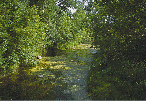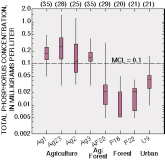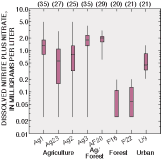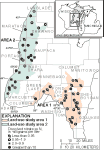Water Quality in the Western Lake Michigan Drainages, Wisconsin and Michigan, 1992-95
Table of contents || Previous section || Next section || Glossary
Applications of phosphorus and nitrogen to croplands, urban lawns, and golf courses, in the form of commercial fertilizers and(or) animal manure, are common in the study area. In drinking water, concentrations of nitrate in excess of 10 mg/L can cause methemoglobinemia or "blue-baby syndrome" which can be fatal to infants.
 (78,366 bytes)
(78,366 bytes)
Nutrients are essential for aquatic plants; however, in high concentrations they can cause eutrophication, leading to nuisance algal blooms. Algal blooms can be detrimental to fish and other aquatic organisms.
More than 96 percent of the total anthropogenic phosphorus input to the study area is in the form of commercial fertilizers and livestock manures. Point sources such as sewage-treatment plants contribute only about 1.2 percent of the total input (Robertson, 1996a).
Phosphorus is naturally occurring and present in many clay soils in the study area. Man supplements this naturally occurring phosphorus with total annual inputs to the study area of 34 thousand tons (6.8 pounds per acre). Phosphorus concentrations at the 11 Fixed Sites were primarily related to land use and secondarily related to clayey surficial deposits in the basin. Median phosphorus concentrations exceeded the USEPA suggested maximum total phosphorus concentration for flowing water of 0.1 mg/L (U.S. Environmental Protection Agency, 1986) in 57 percent of samples collected at the four agricultural sites (Richards and others, 1998).
 (7,310 bytes)
(7,310 bytes)
Phosphorus concentrations in stream water at agricultural sites were considerably higher than at urban and forested sites during base flow conditions. (RHU labels correspond to the RHU figure on p. 6.)
Nitrate was detected in all 412 stream-water samples collected during the study. Concentrations in 66 percent of all stream samples and 92 percent of samples from agricultural sites were high enough to contribute to algal blooms (0.3 mg/L).
Median nitrate concentrations at the four agricultural sites and the mixed agriculture and forested sites were slightly higher than at the urban site and considerably higher than at the forested sites. Nitrate concentrations at the agricultural East River site exceeded the USEPA MCL (10 mg/L) during three storms in 1994 and 1995. Median nitrate concentrations in river water from Lincoln Creek, the urban site, were similar to the national average concentration (Smith and others, 1993) in urban areas and are probably elevated relative to forested land use areas due to the use of fertilizers on lawns and gardens.
 (7,003 bytes)
(7,003 bytes)
Median nitrate concentrations, during base-flow conditions, at two of the agricultural sites and the mixed agriculture and forested sites were twice the national average concentration for agricultural areas (Smith and others, 1993). (RHU labels correspond to the RHU figure on p. 6.)
Nutrient concentrations vary seasonally in streams throughout the study area. The highest concentrations occur during stormwater runoff. At two agricultural streams in the study area, more phosphorus was carried during storms in June 1993 than during the next 24 months combined. Highest phosphorus concentrations during periods when storm runoff is absent (base flow) generally occur during the growing season (March to August), and the lowest concentrations occur during the winter (January and February). Highest nitrate concentrations during base-flow periods generally occur during the winter months. This may be due to the seasonal change in contributions from ground-water discharge to streams or to the seasonal cycle of algae growth in streams.
The highest nutrient concentrations occurred during periods of precipitation runoff.
Nitrate was detected in all 76 ground-water samples collected. Concentrations of nitrate exceeded the USEPA MCL of 10 mg/L in 9 percent of samples from the drinking-water aquifer and in 22 percent of samples from the surficial alluvial aquifers.
 (19,475 bytes)
(19,475 bytes)
Water samples from 22 percent of shallow alluvial wells sampled in agricultural land-use areas exceeded the USEPA maximum contaminant level for nitrate as nitrogen of 10 mg/L. Nitrate concentrations were higher in land use area 2 where surficial deposits were more permeable (Saad, 1997). Typically, these shallow wells are not drinking-water sources.
In general, ground water had higher concentrations of nitrate in areas of agriculture or mixed agriculture and forested land use than in urbanized and forested watersheds. Ground water from the surficial alluvial aquifer generally had higher concentrations of nitrate than that from wells in the Cambrian-Ordovician drinking-water aquifer (Saad, 1996 and 1997). Concentrations of nitrate in the drinking water aquifer were highest in areas where the Sinnipee confining unit is not present. Ground water in areas where the surficial deposits were sand and gravel had higher nitrate concentrations than in areas where the surficial deposits were sand and clay glacial till (Saad, 1996).
|
More than 20,000 samples from more than 500 stream sites and nearly 1,000 samples from about 800 wells in the study area were analyzed by various agencies for nutrients between 1970 and 1991 (Robertson and Saad, 1996; Saad 1994). Retrospective analysis of these data indicated that agricultural land use was the primary factor affecting the distribution of nutrient concentrations. Phosphorus concentrations decreased significantly in surface water downstream from urban areas during the 1970s because of the reduction of phosphorus in detergents and improvements in sewage-treatment facilities. |
U.S. Geological Survey Circular 1156
Table of contents || Previous section || Next section || Glossary
Suggested citation:
C. A. Peters, D. M. Robertson, D. A. Saad, D. J. Sullivan, B. C. Scudder, F. A. Fitzpatrick, K. D. Richards, J. S. Stewart, S. A. Fitzgerald, and B. N. Lenz, 1998, U.S. Geological Survey Circular 1156, on line at <URL: https://water.usgs.gov/pubs/circ1156>, updated June 11, 1998